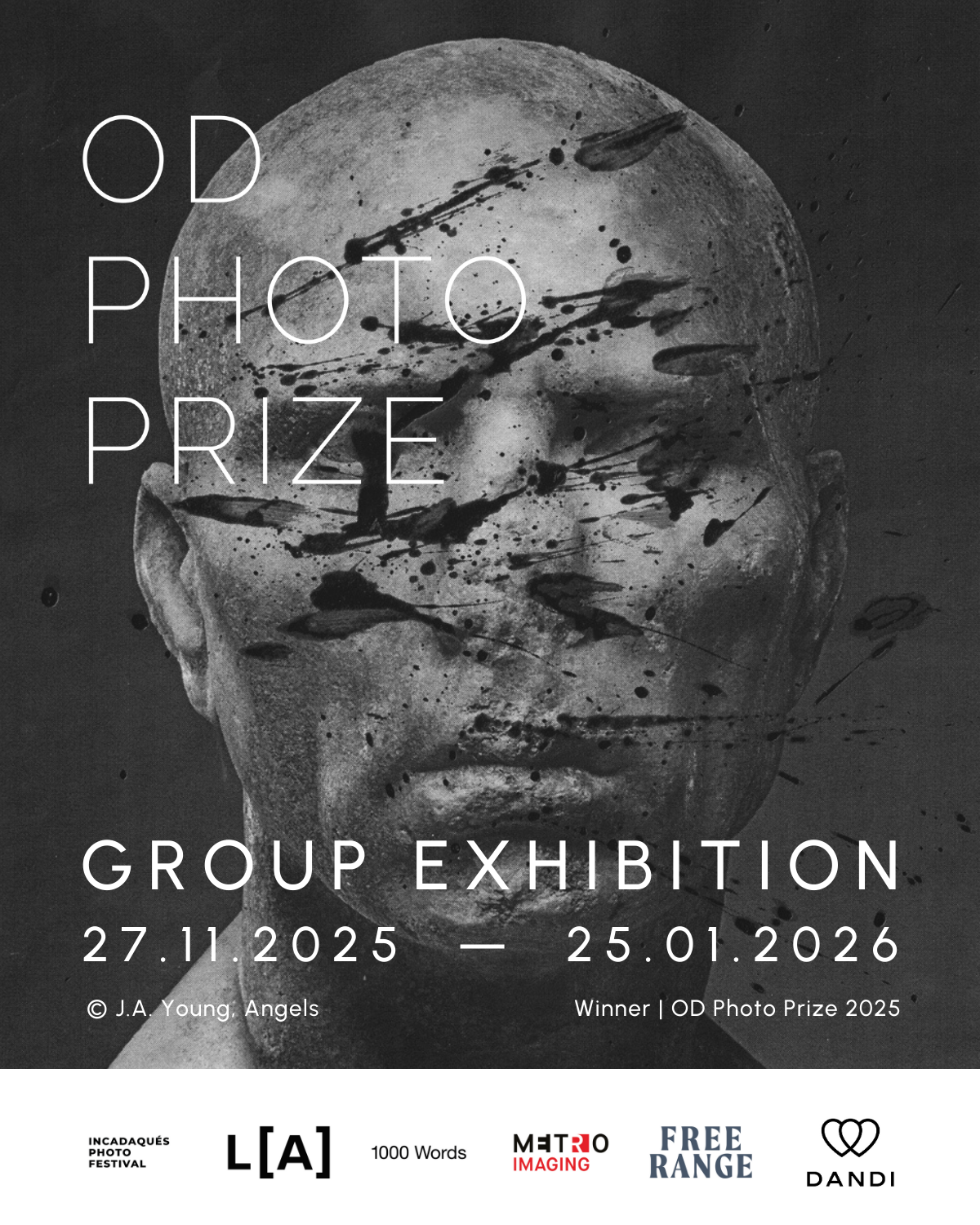This year’s AJ Page Award celebrates outstanding single images from the artists who narrowly missed the shortlist for the OD Photo Prize. While the OD Prize focuses on broader photography projects, the AJ Page Award spotlights individual images with impactful narratives, unique perspectives, and artistic excellence.
The 10 selected images are showcased on the @odtakeovers Instagram account, where everyone is invited to vote by commenting with the corresponding number of their favourite image. These votes will help determine which artist earns a place in the end-of-year exhibition and print sale at Dandi in Battersea this November.
Prints from this sale will be available only for the duration of the exhibition 27 Nov—25 Jan. So time-limited editions of 10×8″ c-type prints. Printed by our long term partners, Metro Imaging, here in London… So perhaps consider which of the images above would make the best print for your home!
How to Vote
Visit the @odtakeovers Instagram post featuring the AJ Page Award images.
Comment with the number of your favorite image on the post to cast your vote.
Voting starts 30 October, from 4pm GMT
Voting ends 7 November, Midday

This series is a meditation on healing on the unseen weight of trauma, the layers of memory, and the quiet strength it takes to return to oneself. Using water as both metaphor and mirror, Recovery explores the space between past and present, solitude and support.
From the internal conflict of self (The Present Vs The Past), to the necessity of connection (No One Is an Island), to the breaking point of liberation (Escaping Trauma), these images tell a story not just of what was survived, but of what is being reclaimed… Recovery is not a single moment. It is a slow emergence a rising.
I began my artistic practice in 2018 with a phone, discovering a visual language through simplicity. That start shaped my focus on vision over equipment.
Nana Frimpong | @frizzlemadeit

In 1523, Margherita “Madregna” was accused of witchcraft, tortured, and burned alive—one among countless women persecuted across Europe between the 15th and 18th centuries under the guise of religious and moral order. What began as superstition evolved into a system of control that criminalized female autonomy, with midwives, healers, widows, and dissenters branded as witches for their knowledge or independence. Manuals like the Malleus Maleficarum codified this violence, legitimizing torture and execution as instruments of fear. Though the last witch trial ended in 1782, the logic of domination endured—from fascist Italy’s confinement of “deviant” women to today’s epidemic of femicide. These fires still burn, in new forms, reminding us that the persecution of women is not just history but a legacy demanding remembrance and justice.
Alessandro Silverj (Rome, 1991) is a self-taught photographer with a background in literature and philosophy. He blends analog and digital techniques in a social and autobiographical exploration, crafting evocative narratives suspended between nightmares and reality.
Alessandro Silverj | @alessandrosilverj

A major childhood illness and multiple surgeries left me with scars that became inseparable from my identity, pain transformed into something symbiotic with life itself. Returning to my hometown after the pandemic, I found both the place and its people changed, silence having eroded memory. Revisiting the building where I was born, now renovated and stripped of its traces, I uncovered my mother’s photo albums documenting those years of illness and endurance. Between these physical and emotional spaces, I search for remnants of the past and a direction forward. PAIN NO MORE, my photography book and installation project, emerges from this process, combining film-based images, experimental darkroom techniques, and doll installations to explore healing, memory, and transformation.
Born in 2000 in Guangdong Province, China, Jieyu Deng is a photographer and graphic designer based in Glasgow. Inspired by the Japanese photographers of the 1970s, Jieyu Deng’s work specialises in the use of film and darkroom techniques.
Jieyu Deng | @sukekiyo_hitmol

A Template For Their Desires explores how women’s identities are shaped and constrained by societal expectations, using the image of a solitary female figure adorned with fragile balloons as a metaphor for the invisible burdens and projections placed upon women. Shot in confined spaces in Ile Ife, Nigeria, the series visualizes the tension between individuality and conformity, fragility and endurance. Drawing on personal observations of women close to the artist, it transforms intimate experience into a broader reflection on gender and cultural pressures, particularly within African contexts where tradition, religion, and modernity intersect. Through stylized visual storytelling, the work reframes the female subject as both muse and mirror, inviting viewers to question who defines womanhood, and at what cost.
David Olayide is a lens-based artist from Nigeria, whose works explore cultural identity, and environmental sustainability
David Olayide | @olayidedavid

ETA2824-2 explores how nature’s quiet rhythms offer solace, belonging, and strength to sensitive souls in a noisy world. Living in a foreign land has heightened my sensitivity to time and the relentless pace of life. In a society that often celebrates extroversion, I turn to my camera to find stillness and creative energy in nature’s subtle gestures such as leaves rustling, birds gliding and calling, and branches swaying in the wind. These organic rhythms speak to me. Are they chasing the wind, or simply dancing with it? Am I part of this dance?… In these moments of solace, I am no longer chasing others’ pace, seemingly untouched by the burden of time.
From being a retoucher to a photographer and content creator at an advertising agency in Hong Kong, and later a master’s student in photography, King Chuen Mario Wong has continuously pursued a deeper connection with photography and its ability to connect him with others
Mario Wong | @mariowrong

Grim is a dark fantasy and allegory created during long walks through Germany’s Ahr Valley and rural west. Told like a fable, it follows a lonely child living in a cold, wind-blown house on a hill above a forest filled with strange, unearthly beings. The forest calls to her, softly, insistently, until, driven by isolation and longing, she finally enters its depths. There she meets a god who offers transcendence in exchange for her spine. When she agrees, the god plants it in the earth, and the world that unfolds, the faces, creatures, and landscapes that emerge, is the dream her spine dreams as it takes root. The series exists within that dream: a meditation on transformation, sacrifice, and the blurred boundary between myth and memory.
D.M. Terblanche (b. 1998, South Africa) is a self-taught multidisciplinary artist working primarily in photography. Their practice focuses on narrative documentary and portraiture, drawing from storytelling traditions across media to explore both personal and constructed realities.
D.M. Terblanche | @d.m.terblanche

In April, I traveled with writer Yatou Sallah to Janjanbureh, a river island in The Gambia, to document the Kankurang masquerade—an ancestral Mandinka ritual where textiles become conduits between the human and the spiritual. With guidance from archaeologist Musa Foone, we were granted rare access to the complete transformation from raw materials to sacred costume, witnessing how bark from the camel foot tree turns man into spirit. Our journey revealed textiles as expressions of collective wisdom, connecting people, environment, and belief. Yet, amid deforestation, tradition has adapted: synthetic materials now replace natural fibers, giving rise to the Nifirr—meaning “movement”—a symbol of resilience and renewal. In this evolving ritual, the sacred and the sustainable intertwine, showing how even within change, heritage continues to breathe and transform.
In pursuance of documenting the world’s beauty while reaching below the surface, Christian Cassiel’s subject matters traverse portraiture, ecology and space. His work explores the intersections of identity, materiality and spirituality, finding equal resonance in local landscapes and international communities.
Christian Cassiel | @christiancassiel

Memories of Dust is a post-documentary exploration of traditional masculinity in Texas, reexamining the myth of the cowboy, a figure long idealised in popular culture as the embodiment of rugged, stoic manhood. Traveling across ranches and rodeos, I immerse myself in the everyday lives of cowboys to contrast their lived realities with the cultural archetype that shaped my own understanding of manhood. By incorporating familiar visual codes of the Western narrative, the series both echoes and disrupts the myth, revealing moments of vulnerability and connection often excluded from its portrayal. Ultimately, Memories of Dust reflects on how these inherited ideals continue to influence identity, prompting a reconsideration of what masculinity means in a changing world.
Alex Bex (b. 1993) is a French-Texan photographer based in Berlin. His work explores the impact of popular visual media on traditional representations, particularly focusing on masculinity and its social construction. Through his photography, he engages with the cultural narratives he was brought up with to study and challenge them.
Alex Bex | @alxbx

Underwood is a quiet meditation on memory, loss, and the evolving shape of family, set within the walls of a century-old English house. Following the death of her older brother, British photographer Barkat—born to Indian parents—uses the home as both refuge and witness, tracing how grief reshapes familial bonds and domestic space. Working from a diasporic consciousness, her images merge intuition and precision, mapping absence through subtle gestures rather than spectacle. Curtains, floorboards, and light become vessels of transition, carrying echoes of those who came before. In folding personal history into the architecture of the house, Underwood transforms private mourning into a universal reflection on belonging, time, and the silent persistence of love.
Barkat Mehra is a photographer born in the UK to Indian parents, working between places, histories, and the quiet spaces in between. She graduated from Tufts University in 2024 with a BA in Economics and a BFA, where her practice began as a way of navigating memory, distance, and the shifting contours of belonging through images.
Barkat Mehra | @barkatmehraart

In this series, themes of alienation, facelessness, and emotional detachment unfold through a visual dialogue between the human figure and its environment. The works shift focus from people to the inanimate, objects, mirrors, and lifeless forms that enclose or reflect emotionless faces. Contrasts of texture and tone, soft and hard, light and heavy, angular and smooth, create a tension between beauty and unease. The figures, described as “prisoners,” appear trapped within reflective surfaces or the shapes that surround them, suggesting both confinement and disconnection. Insects, incorporated as accessories, blur the boundary between the organic and the artificial. In these compositions, the human becomes a mere element of the environment, as the visual allure of soft colors and balanced rhythms contrasts with the unsettling restraint of their content, revealing a quiet dissonance between form and feeling.
Born in 1990 in Shostka city, Ukraine. As a child, I was fond of researching and collecting insects, and now this passion is reflected in my work. And the very acquaintance with photography happened gradually: starting with macro photography of flowers, landscapes with the help of a little soapy canon. Later, I switched to portraiture, photographing beautiful girls, mostly with freckles. In such shootings, I most often used a complementary combination of colors.
Billi Rubin | @billi_rubin

